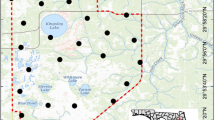Abstract
The US Department of Defense (DOD) manages over 10.1 million ha of land, much of which is used for training military personnel. However, vast sections receive little or no use, and military lands have become refuges for many species. At Fort McCoy, Wisconsin, USA, populations of the endangered Karner blue butterfly (Lycaeides melissa samuelis) are found in oak and pine barren communities where wild lupine (Lupinus perennis), a perennial forb required by Karner blue butterfly larvae, still occurs. Oak and pine barren communities are disturbance-dependent, and the barrens ecosystems in the Midwest have declined in extent by 98% because of fire suppression, succession, and habitat fragmentation. We studied the effects of disturbance by military manuever training on the density of lupine and Karner blue butterfly at Fort McCoy. We also wanted to determine whether military training activity could enhance Karner blue butterfly habitat.
At locations where tracked vehicles had driven through lupine patches, the abundance of lupine and nectar-producing plants was greater in the median strip between vehicle ruts than in vehicle ruts or 5 m outside the vehicle ruts. The proportion of lupine stems with Karner blue butterfly larvae feeding sign (the ratio of stems fed upon to stems examined) was greater in areas where military vehicles had traveled than where they had not. The proportion of lupine stems with feeding sign and lupine stem density was also positively related to the occurrence of prior bivouacs and fires caused by military munitions. Shrub and forest canopy abundance were lower in areas traveled by tracked vehicles. At the scale of the lupine patch, lupine abundance and the proportion of lupine stems with feeding sign were positively correlated with military training activities, suggesting that maintenance of lupine habitat can be achieved in concert with military training.
Similar content being viewed by others
Author information
Authors and Affiliations
Rights and permissions
About this article
Cite this article
Smith, M., Turner, M. & Rusch, D. The Effect of Military Training Activity on Eastern Lupine and the Karner Blue Butterfly at Fort McCoy, Wisconsin, USA. Environmental Management 29, 102–115 (2002). https://doi.org/10.1007/s00267-001-0044-9
Published:
Issue Date:
DOI: https://doi.org/10.1007/s00267-001-0044-9




